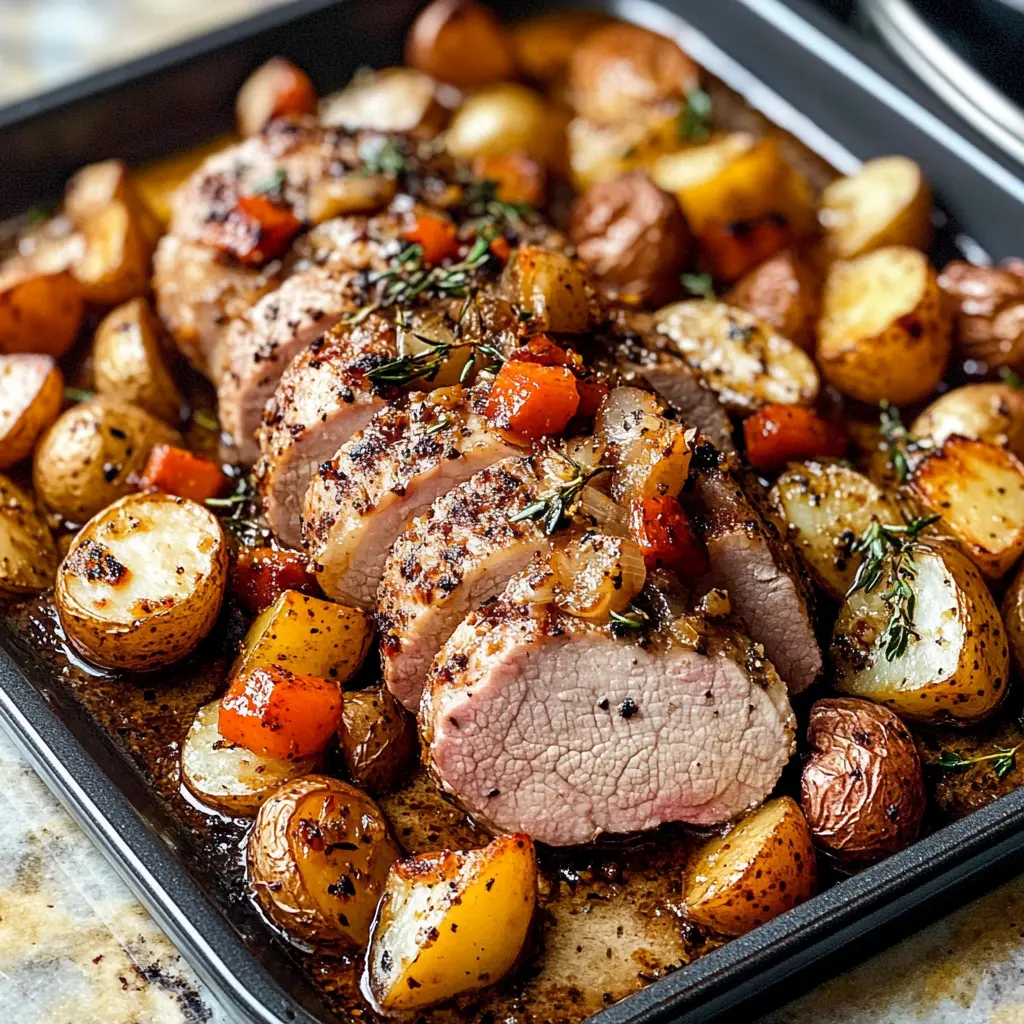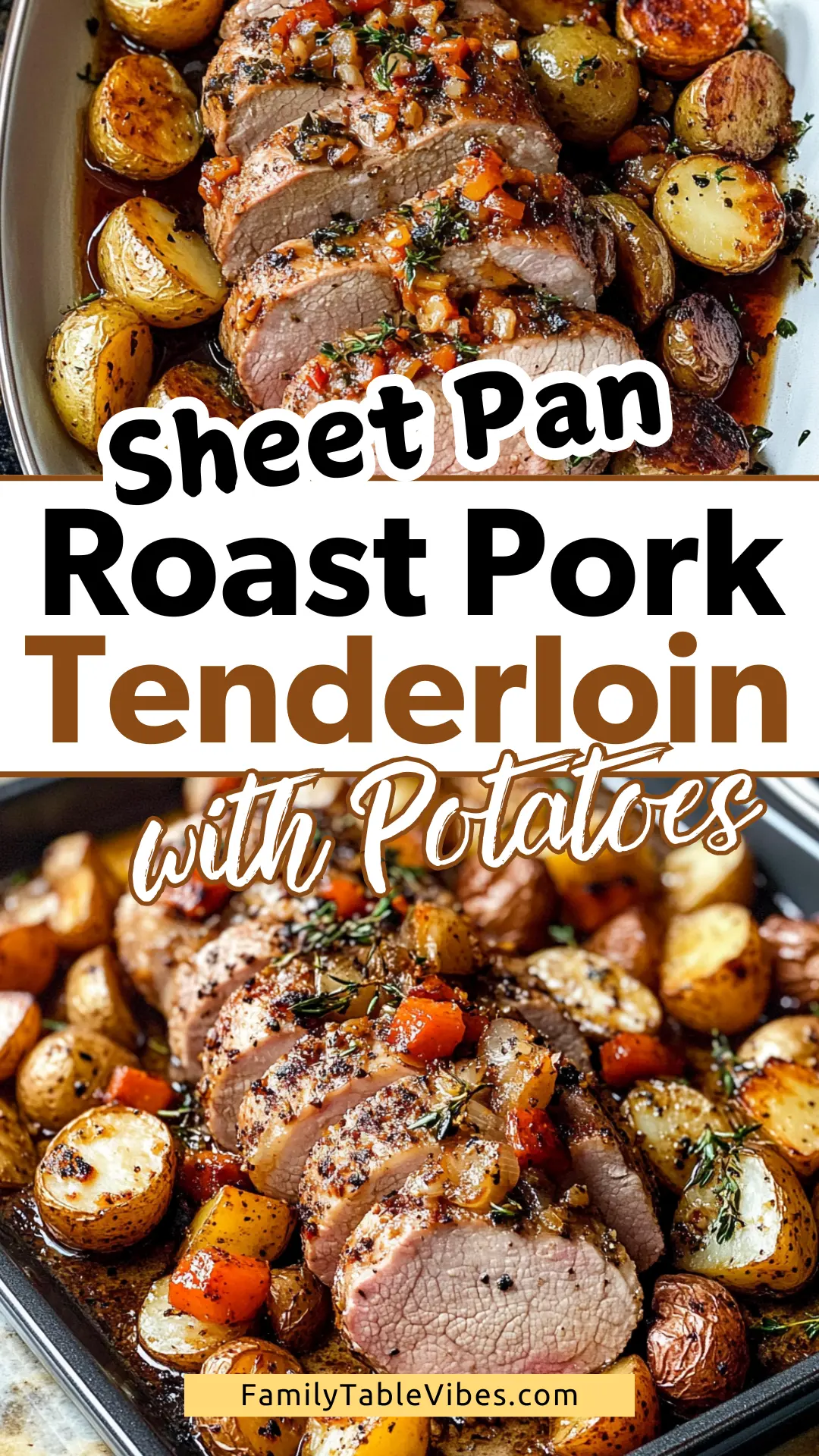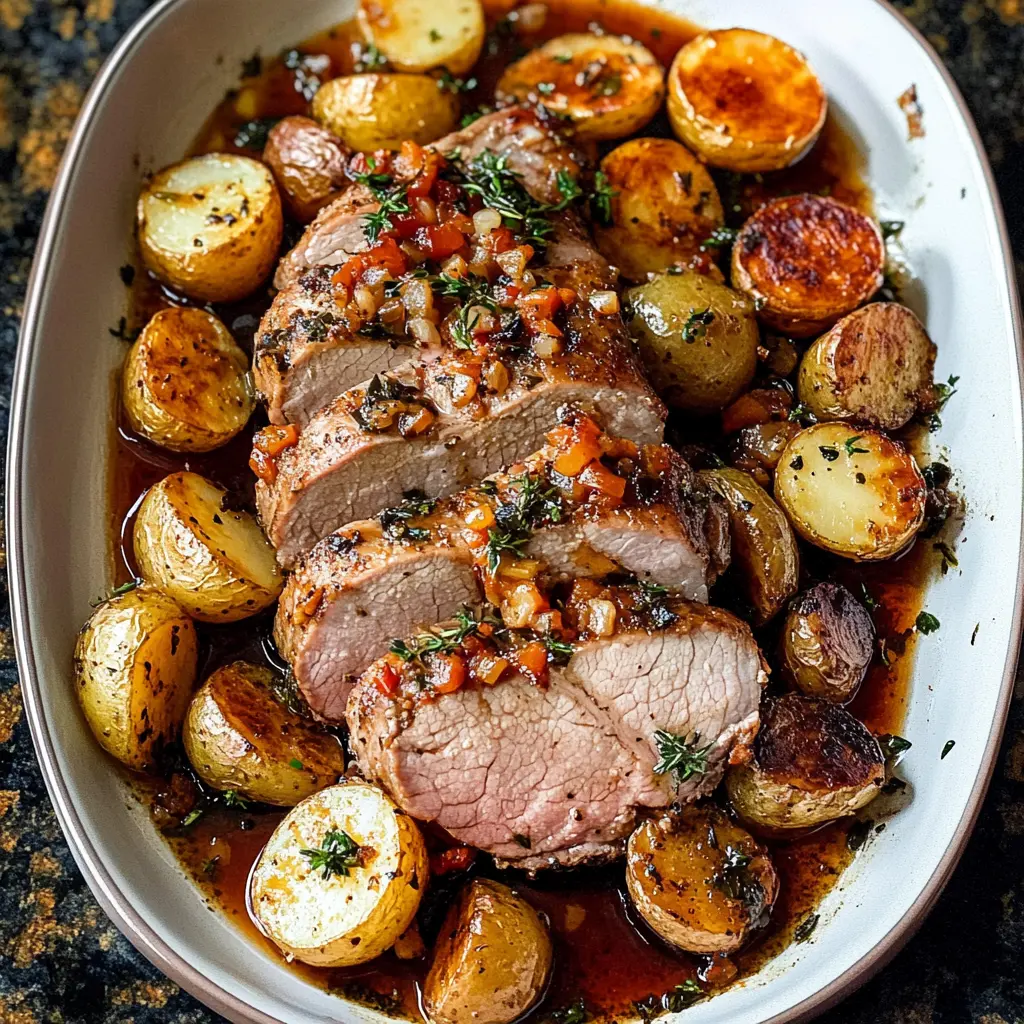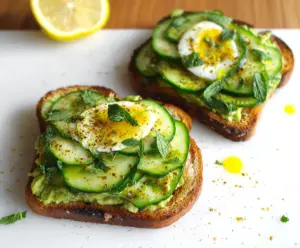This sheet pan roast pork tenderloin is a one-pan wonder! Juicy pork and perfectly roasted potatoes come together for a tasty meal that’s also easy to clean up.
Who doesn’t love a dish that cooks all at once? My kitchen smells amazing while this is baking, and I always sneak a few crispy potato bites while I wait. They’re irresistible!
I appreciate how simple it is—just season, pop it in the oven, and in no time, dinner is served. It’s perfect for busy weeknights when I crave something hearty without the fuss.
Key Ingredients & Substitutions
Pork Tenderloin: This is the star of the dish! It’s lean and cooks quickly. If you can’t find tenderloin, a pork loin roast can work, but be sure to adjust the cooking time since it’s larger.
Baby Potatoes: I love using baby potatoes for their creamy texture, but you can use any small potato variety like red or fingerling potatoes. Just keep them whole or cut into quarters for even cooking.
Garlic: Fresh minced garlic packs the best flavor. If you’re out of fresh garlic, use 1/4 teaspoon of garlic powder per clove. Adjust to your taste!
Herbs: Fresh rosemary and thyme brighten up the dish! If you don’t have fresh herbs, use 1 teaspoon of dried herbs instead. Just remember to use less dried, as they are more potent.
Balsamic Vinegar: This ingredient adds depth and sweetness. If you prefer, you could replace it with red wine vinegar or apple cider vinegar for a different flavor profile.
Bacon: Adding diced bacon brings a smoky richness. If you’re looking for a healthier option, you can skip it or use turkey bacon for less fat.
How Can I Achieve Juicy Pork Tenderloin?
The key to juicy pork tenderloin is all in how you prepare and cook it. Here are some tips to ensure it stays moist and flavorful:
- Do not overcook the pork! Use a meat thermometer for accuracy. Remove it from the oven at 145°F (63°C) and let it rest.
- Resting is crucial! Allowing the meat to rest for 5-10 minutes lets the juices redistribute, making for a tender slice.
- For extra flavor, consider brining the pork in a simple saltwater solution for a few hours prior to cooking.
- Frequently baste the pork with the pan juices while it roasts for added moisture and flavor.
Following these tips will help you achieve a delicious and satisfying roast pork meal! Enjoy your cooking!

Sheet Pan Roast Pork Tenderloin with Potatoes
Ingredients You’ll Need:
For the Pork and Seasoning:
- 1.5 to 2 pounds pork tenderloin
- 4 cloves garlic, minced
- 1 tablespoon fresh rosemary, chopped
- 1 tablespoon fresh thyme, chopped (plus extra for garnish)
- 1 teaspoon paprika
- 1 teaspoon onion powder
- 1 teaspoon salt
- 1/2 teaspoon black pepper
- 2 tablespoons olive oil
- 1 cup chicken broth
- 1/4 cup balsamic vinegar (optional for additional flavor)
- 1/2 cup diced bacon (optional, for a smoky flavor and garnish)
For the Potatoes:
- 1.5 pounds baby potatoes, halved
How Much Time Will You Need?
This wonderful sheet pan meal requires about 10 minutes for prep and 30 minutes for cooking, making the total time approximately 40 minutes. It’s quick, easy, and full of flavor—perfect for a busy family dinner!
Step-by-Step Instructions:
1. Preheat Your Oven:
Start by preheating your oven to 425°F (220°C). This high temperature will help you achieve a nice, golden finish on both the pork and potatoes.
2. Prepare the Seasoning Paste:
In a small bowl, combine the minced garlic, chopped rosemary, chopped thyme, paprika, onion powder, salt, pepper, and 1 tablespoon of olive oil. Mix it all together to form a flavorful seasoning paste. This will add a delicious taste to the pork!
3. Season the Pork Tenderloin:
Take the pork tenderloin and rub the seasoning paste all over it. Make sure it’s evenly coated so every bite is bursting with flavor. Set the seasoned pork aside while you prep the potatoes.
4. Toss the Baby Potatoes:
In a large bowl, toss the halved baby potatoes with the remaining tablespoon of olive oil, salt, and pepper. Give them a good mix until they’re well coated. This will ensure the potatoes roast nicely in the oven.
5. Arrange on the Sheet Pan:
Place the seasoned pork tenderloin in the center of a large baking sheet or sheet pan. Arrange the coated baby potatoes around the pork. This setup allows the flavors to mingle as they cook!
6. Add Liquid and Optional Ingredients:
Pour the chicken broth around the pork and potatoes. If you want an extra punch of flavor, drizzle the balsamic vinegar over it all. To make things even tastier, you can sprinkle the diced bacon over the potatoes at this point.
7. Roast Everything Together:
Pop the sheet pan into your preheated oven and roast for about 25-30 minutes. Keep an eye on it! You’ll know it’s done when the pork reaches an internal temperature of 145°F (63°C) and the potatoes are tender and golden brown.
8. Let the Pork Rest:
Once cooked, take the sheet pan out of the oven and let the pork rest for 5-10 minutes. This helps keep the meat juicy and flavorful.
9. Slice and Serve:
Finally, slice the pork tenderloin into pieces and serve it up alongside the roasted potatoes. Don’t forget to drizzle the delicious pan juices over everything. Garnish with a bit of fresh thyme for that extra touch.
Enjoy this delightful sheet pan meal that’s sure to please the whole family!

Can I Substitute Another Cut of Pork for Tenderloin?
Absolutely! If you don’t have pork tenderloin, you can use pork loin or pork chops instead. Just be aware that cooking times may vary. Pork loin may take a bit longer, so aim for an internal temperature of 145°F (63°C) as well.
Can I Use Different Vegetables Instead of Potatoes?
Yes, you can mix it up! Vegetables like carrots, Brussels sprouts, or green beans work great. Just ensure they are cut into even sizes for uniform cooking. You may need to adjust the cooking time depending on the vegetables you choose.
How to Store Leftovers?
Store any leftovers in an airtight container in the fridge for up to 3 days. Reheat gently in the microwave or in a preheated oven at 350°F (175°C) until warmed through. To keep the pork moist, add a splash of chicken broth while reheating.
Is the Balsamic Vinegar Necessary?
No, it’s optional! The balsamic vinegar adds a nice tangy flavor, but you can omit it if you prefer. Alternatively, you can substitute it with apple cider vinegar or lemon juice for a different flavor profile.



